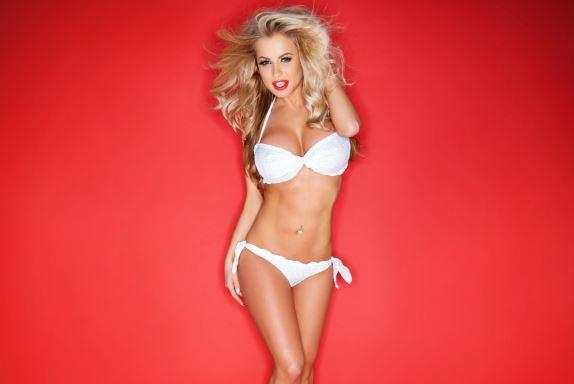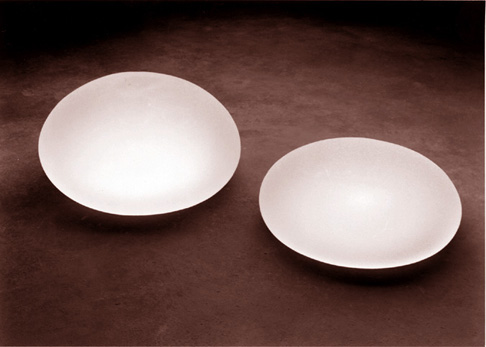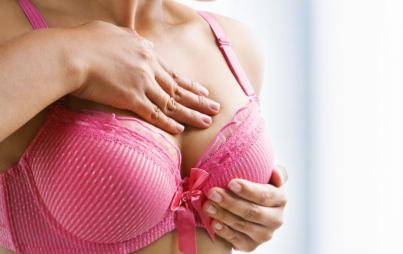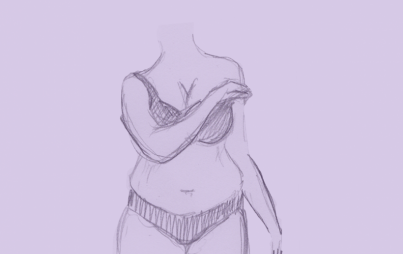
Credit: ThinkStock
Alright, I admit it: I'm a straight woman, and I like big boobs. What can I say? I find them beautiful and, with their supple curves and bounce, more than a little erotic. I've skimmed the pages of Playboy more than once, and not just for the admittedly great articles. During sex, I'll also frequently position my body in such a way that my own boobs appear larger—and not even just for my partner, but because they turn me on.
This boob obsession has even tempted me to rebel against my much better instincts and fantasize about getting a boob job. If I had C or D breasts rather than my woefully average Bs, would I feel sexier in a tight dress, where my bosom would no doubt runneth over? Would sex be more fun if I didn't have to worry about creating the illusion of larger breasts? Would I stand in the mirror naked, blissfully sizing my own busty self up?
This desire, it turns outs, is one I share with millions upon millions of other women; indeed, worldwide, some 1.8 million went under the knife for larger boobs last year alone. And the numbers are growing: In America, breast enhancements shot up a staggering 210% between 1997 and 2013.
But there may be no other country on Earth as addicted to breasts as Venezuela, where it's being reported today that there's an actual implant shortage. Out of a population of more than 30 million, 38,500 Venezuelans got boob jobs last year—making the country slightly more bigger-breast-enthused than the U.S., where the rate is 313,000 surgeries out of a population of 313 million. And this is in a nation where the GDP (Gross Domestic Product) is significantly lower than ours.
Said Daniela Holmes, a twentysomething Caracas native:
“It’s our version of a bat mitzvah. You’re a woman, you get fake boobs now.”
As a feminist, I've always felt deeply conflicted about the whole boob job thing. On one hand, it's both sad and ridiculous that women feel compelled to pay thousands and undergo surgery to attain an ostensibly "more desirable" body. It's one of those things I imagine aliens from another planet would find utterly confounding, should they ever examine our planet's traditions. On the other hand, shouldn't women be able to do whatever they damn well please to their own bodies without a barrage of scrutiny and judgement? And of course, my own desire for bigger boobs complicates the matter further.
Setting aside these rather tangled socio-cultural questions, another query arises: How did boob-enhancement fever start anyway? Here the story becomes quite interesting.
Breast Implants: A Brief History
The first published account of breast augmentation came in 1895, when Vincenz Czerny attempted to enhance a woman's breast with lumbar lipoma—that is, tissue from a tumor. Other early materials used in attempted breast augmentations—often with disastrous results—include ivory, glass balls, ground rubber and ox cartilage. (Retch.)
Another early material used to make boobs bigger was paraffin, a type of wax more commonly found in candles. In their hopes to lure bosom-obsessed American servicemen, Japanese prostitutes had their breasts injected with the wax in the 1940s.
It wasn't until the 1960s that two plastic surgeons from—where else?—Texas developed the first silicone breast implants. Their first patient? Esmeralda . . . a dog.
Said Thomas Biggs, a junior resident who worked with the surgeons:
"I was in charge of the dog. The implant was inserted under the skin and left for a couple of weeks, until she chewed at her stitches and it had to be removed."
Following this auspicious debut, the implants were inserted into a brave real-life woman, and mother of six, named Timmie Jean Lindsey. She loved the results and a craze was born. 
Over the years, of course, silicone breast implants have faced plenty of scrutiny. In the 1970s, women began filing lawsuits about painful ruptured implants, and in the 1980s, Ralph Nader's Public Citizen Health Research Group sent out warnings about breast augmentation causing cancer. These and other scares paved the way for the FDA's approval of saline implants in 2006, though silicone has since been approved as perfectly safe, too.
And as for today? Innovation marches on.
The Future Of Bigger Boobs
Last February, the FDA approved what's been called, we kid you not, the "Gummy Bear Implant"—not because it literally involves stuffing breasts with bouncing sugary confections (although we wouldn't put it past them) but because the implant itself feels like a gummy bear. (Which I guess is a good thing?)
Currently there's also controversial talk of stem cell breast implants becoming the latest rage. The idea behind the procedure? Harvest stem cell-rich fat from the stomach or thighs, and inject it into the breasts. (This "medical breakthrough" was actually developed for surgery post-mastectomies.)
I must admit, these fat-graft, silicon or saline sacks don't really sound like things I'd ever want to put into my body—big boob desire be damned. In the end, I also think I fall more into the "nay" camp when it comes to the ethics of changing one's body to fit an (arguably) external beauty ideal.
That said, I doubt I'll stop admiring big breasts anytime soon . . . fake or real.






